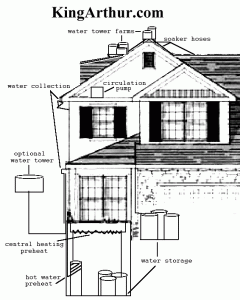Economics Of Alternative Energy Consumption
This article is part of a series on The Waterfall House energy experiment.
At the beginning of a this experiment, an economist said, “Using water will be cheaper than using electricity to control our environment.” A scientist said, “It can not be done.” So, the economist set-up the scientific experiment in an attempt to prove the economics of — substituting the sun (solar), the rain (hydro) and geothermal techniques for traditional electric and fossil fuel consumption.
After several months, the economist was pleased that the scientific experiment was a success. Cooling a home with evaporation is much cheaper (more economical) than with electricity. In the winter months, similar techniques and be used to conserve on traditional heating methods.
Independently, the scientist happened upon the same economic theory.
This confirmed a major breakthrough. Substituting water for electricity had not been done before. It was like comparing apples to oranges. Now, it was like comparing apples to apples… or, perhaps like turning water to wine?
The confirmation came when the scientist said to the economist, “Yesterday I was outside washing the windows (yes i checked to see they were shut first.)
I began to think… the air conditioning is humming… the sun is shining bright… and the water dries rapidly. Wow! Every cubic foot of water that evaporates takes 61000 BTU with it.”
Now, lets think about air conditioning efficiency. There are mandated air conditioner SEER ratings of 10. That means, the air conditioner has to move 10 BTU of heat out of a house for every BTU of electric that it uses.
Every cubic foot of water evaporating off the side of the house makes the air conditioner eat 6100 less BTU of electric. That is 1.78 KWh.
Electric is approximately 8.5 c/KWh here.
So, every cubic foot of water that evaporates saves 15 cents of electric.
Water is 4c/cubic foot here.
You can do the rest of the math.
There are worse ways to spend the afternoon… and seeing that today is another nice hot sunny day… and that I have to hose out my recycling trashcans…
I broke the hose out and thought some more. The first thing I thought of was a cold beer.
That taken care of, I set it down and crawled behind the groaning air conditioner compressor in back of the house.
I see a 15 amp 220V circuit, actual running rating is 12 A (with various fusing options for startup current… this does not include fan motors indoors… therefore, I will use the 15 A number.) That works out to be 3.3KW unit… 3.3KWh per hour… 1 cubic foot of water saves 1.78 KWh. Every cubic foot evaporated shuts my air conditioner off for 32 minutes. I crawled out, took a deep swig, smiled broadly and set the hose on ‘kill’.
Of course, this is an experiment. I will need to keep track of indoor and outdoor temperature and humidity, and water usage and a bunch of other stuff like air conditioner running time… and utility bills… in my copious spare time… watch this space for further details.
Then, I pondered. Should I say to myself, “SHHHHH! Don’t tell anyone!” After all, what happens if everyone starts doing it? This is one reason I insist on using waste or re-cycled water. Because if everyone starts using tap water, the price of water and of electricity will likely strive for equilibrium. (Water companies will be able to demand a higher price from you. What would you pay? Up to 14.995c/cubic?)

